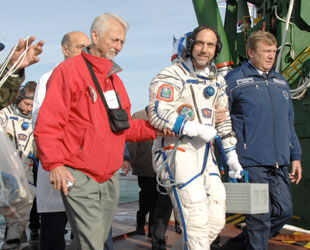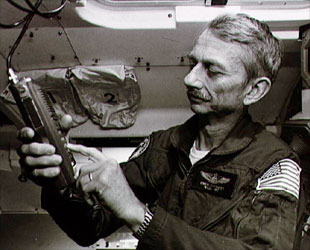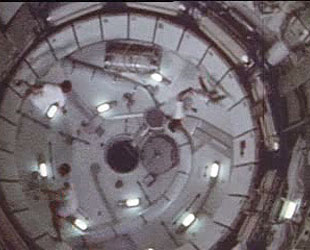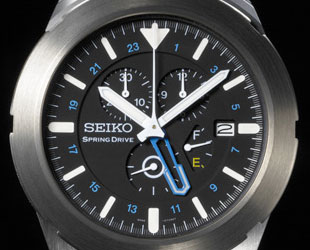October 14, 2008 — Richard Garriott's approach to the International Space Station (ISS) this morning may have seemed familiar to him, even though this was his first flight in space. That feeling could be attributed in part to the six months of training he underwent for the mission, but it might also have been what happened when he was twelve, or more appropriately, what his father did then.
Consider it generational déjà vu.
Thirty-five years ago, seated in the right seat of a three man capsule, Owen Garriott docked with a space station. This morning, Richard Garriott did more or less the same thing. It wasn't the same spacecraft, nor the same space station, but the father's and son's missions share a lot in common.
Space runs in the family
Owen Garriott was selected to be one of NASA's first six scientist-astronauts when Richard was four years old.
"He's grown up in this program," shared the elder Garriott in an interview with collectSPACE.com. "He's known about space since he was old enough to talk, almost."
Richard's path to space however, was not to be through NASA. Told that his eyesight would preclude his being eligible, he never applied for the astronaut corps. Instead, he made a name — and fortune — for himself developing computer games, including the very popular Ultima series and most recently, Tabula Rasa.
Still, growing up in Houston the son of an astronaut had a way of catching up with him.
"June Scobee, the wife of Challenger commander Dick Scobee, was actually my high school science teacher," explained Richard. "After the Challenger accident, which was intended to be the first Teacher in Space flight, the families of the Challenger astronauts got together and wanted to build a living educational memorial. Knowing I was very active in things like science fairs and already starting in the business of computer games, June came to me and I helped work on the designs that eventually became what are now the so far, 50 Challenger Center educational facilities that are now spread out around the world."
Then in the mid-1990s, Richard became involved with the X Prize and Space Adventures, aimed at kick starting the commercial space travel market. He personally financed the Russian study that would open ISS flights to privately funded individuals with the intention of being the first. The dotcom bubble burst delayed, but not cancelled his plans. In Sept. 2007, Space Adventures announced that Richard would pay a reported $30 million to fly to the ISS in 2008.
Father and flight manager
From the start, Richard planned to dedicate his time in space to advancing science and who better to turn to for guidance then his scientist-astronaut dad.
"I've been playing a substantial role for quite some time," said Owen. "I've been trying to help with his experimental program all the way through the flight."
Richard's first commercial research partner for the flight, ExtremoZyme, is a biotechnology company co-founded by his father. During his nine days on-board the station, Richard's primary experiment will be focused on protein crystal growth for the company, which is looking to apply the results to better structure-guided drug design.

Owen Garriott walks his son Richard to the launch pad (Energia) |
During today's docking and throughout the mission, Owen has been and will be in Russia's mission control, the TsUP, where he's serving as Richard's science manager.
"That involves not only protein crystal growth... but also a great deal associated with visual observations with the photography that can be done from space looking down at the ground, working with a variety of educational outreach programs such as the Challenger Center, and amateur radio operations," said Owen. "I have been involved in all of these activities for almost a year now and will continue working with Richard during the flight."
The view from space, 35 years later
"As it turns out, Skylab was one of the first times we had an extended human presence in space looking back at the Earth," Richard told collectSPACE.com of the United States' first space station, and the outpost on which his father lived for 59 days in 1973. "I thought it would be an interesting story to go back to the Skylab photo archive, identify scientifically interesting places on the Earth that may have changed — through either natural processes or human intervention — in those 35 years, and try to retake some fraction of those."
Working with The Nature Conservancy to locate potential targets, Richard was intrigued by one set of observations.
"The negative story sites are actually, unfortunately, relatively easy to find and whether that's the recession of glaciers or the expansion of urbanization or desertification or the clear cutting of places like the Amazon rainforest, those stories are very easy to find," said Richard. "But I think it is just as important to showcase the places where land management and/or human practices have actually either sustained or improved the situation."
To improve his chances of photographing the targets as they pass below, Richard will employ new software as a test for future astronauts and cosmonauts.
"The software is called Windows on Earth and it was actually developed by the Association of Space Explorers and hypothetically, or the hope is, is that it will ultimately become a common tool for crew use in space. I'll be the first test subject for this piece of software," said Richard of the application that runs in a web browser.
"You can select which window you are at on the ISS and it will give you countdown timers to all the targets you've inputted into the system. So you can set that right by the window you are looking at and hopefully get a good chance to catch some of those targets photographically."
A couple of hams
As he takes photographs, Richard plans to share the live view using a method his father also pioneered in space.
"My flight comes almost 25 years after the first ham radio contacts made from space, made by my father on STS-9 with a small, 5-watt radio held near the window," observed Richard. "Since I was getting the chance to go up as the first second generation American flier, and have that ham radio connection, it was an opportunity that really couldn't be missed."
"Twenty five years ago, a voice contact itself was quite novel and relatively state-of-the-art. Nowadays however, you can do things like send packet data, e-mail and slow- scan television and things of that nature. A lot of that I will be doing on the ISS, including in particular, I am most excited about the slow-scan TV work. While I am looking out the window taking earth observation photography, I can leave the slow-scan television adjacent to me so that in realtime, what I am looking at through the window will also be broadcast down by ham."

Owen Garriott operates a handheld ham radio on STS-9. (NASA) |
Adding to the history shared between father and son from space will be the call signs they will use to communicate.
"Richard was significantly motivated to get his amateur radio license and then apply for a re-issuance for my father's, his grandfather's call sign," said Owen. "We think that is significant."
"My dad's call sign is W5LFL and my grandfather's call sign was W5KWQ," explained Richard. "So in this case it will be an interesting generational flip: my father got to call down as W5LFL to W5KWQ, I get to do the reverse."
Like father, like son
Some children drive their parents up a wall. In Richard's case, it was the other way around.
"Running the lockers is something that — before I even went to space, before I even thought I might be able to go to space — was high on my agenda," Richard recalled.
While on Skylab, Owen and his crewmates were able to run around the circumference of the station, building up enough centrifugal force to keep them on the flat surface of a ring of lockers. The scene of their indoor track drew comparisons with the station pictured in "2001: A Space Odyssey".

'Running the lockers' inside Skylab. (NASA) |
"I have been trying to figure out where on the International Space Station could this best be performed," Richard told collectSPACE. "One of the great things about Skylab is that it had this massive internal volume and this nice ring of lockers that gave you a relatively smooth surface to make that attempt and a reasonable diameter so that at a nice jog pace, the centrifugal force would do a reasonable job of holding you to the outside wall. The ISS's diameter is much smaller."
The size of the ISS is just one of the concerns Owen had about Richard's chances at 'running the lockers'.
"We found on Skylab that we had to be a bit careful on how often and how vigorously we ran around and did flips because it was upsetting the pointing capability of the Skylab telescope! So we had to make sure to do that at a time when it would not impact negatively our experimental work. Richard needs to make sure he doesn't effect other kinds of experiments that are going on if he should get too vigorous in his attempt to generate centrifugal force."
"We'll have to see what kind of creativity he might be able to use to find some sort of a similar kind of activity," said Owen. "One thing I did suggest is that he might think of jumping from side to side with a half flip in-between and landing on opposite sides of the roughly 15-foot diameter of the space station."
Parental payloads
Richard was able to pack about 30 pounds of equipment and personal items aboard the Soyuz TMA-13 spacecraft that delivered him to the space station at 3:26 a.m. CDT on Tuesday. When he returns to Earth on Soyuz TMA-12 in 10 days, he'll only be able to bring about half that back.
Among those round trip items will be watches designed by Seiko for use in space.
"The Seiko Spring Drive Spacewalk is interesting on a number of levels. Of course, it would be real easy to say it is a commercial opportunity, that I've been paid to take this watch to space, which in fact is true. However, I think there is an interesting story that goes far beyond that," said Richard.

The Seiko Spring Drive Spacewalk watch. (Seiko) |
"What Seiko didn't know is that my father, on his first flight aboard Skylab was looking for mementos to take up for each of my family and at the time, that was when digital watches using quartz crystal timing had first come out. That first quartz crystal technology was invented by Seiko. And so my dad, as with all astronauts, thinking that keeping the accurate time is a very important part of your life as an astronaut, he was so very impressed with Seiko and went out and bought Seiko watches and took them all up for us as kids."
"When Seiko contacted me, I thought that was a cool generational story and so when I first went to talk to them I got my Seiko watch and my father's Seiko watch and took them back to Seiko and so for this year while I've got one of their watches, they have our watches from 35 years ago."
The watches aren't the only pieces of jewelry that Richard took with him. He also has a snake-shaped pendant.
"The pendant has been a part of my life since I was about 11 years old. In fact, I made it before I knew how to make a clasp so it was basically permanently a part of me."
"The only time I have had it off for any length of time was when I sent it to space with my father on his shuttle mission. Now with my own flight it will actually be making its second journey into space, while I'm making my first."
Richard also brought a small amount of Skylab back to space. The abandoned U.S. station reentered the Earth's atmosphere in 1979, raining parts on Australia's outback.
"I have six of the Skylab coins that were made out of some of the fallen debris. I am taking them back with me to orbit to give to my crewmates."
Not that all of his payload and activities were inspired by his father. He also brought an experiment developed with his artist-mother, Helen.
"I'm taking about 15 pieces of art, some created by my mother and some by other artists," shared Richard. "We ran a little contest to have people contribute to what will become, basically, the first official art show in space."
"I'll also be creating some art. I am going to float droplets of colored paint in a little glove box — to avoid painting the entire ISS — and catching them effectively on canvases to try to use the properties of microgravity to create art. Most of that kit I'll be leaving behind, but I will be bringing the results back to Earth."
Father-land
When it comes time for Richard to return home, he will do so with another second-generation space explorer, Sergei Volkov, who is the departing ISS commander and the son of cosmonaut Alexander Volkov.
"When we get to the ground, both our fathers will be on the helicopters that come to pick us up and be there right as we open up the hatch. There should be a great photo opp as we herald in the second generation of spaceflight."
